
Alphabet Z ©

The capital (majuscule) letter Z represents hell or the afterlife in hell following death and the final judgment.
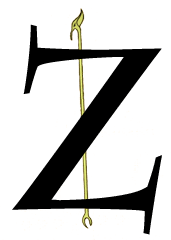
The majuscule letter Z is a picture of Set or the Set scepter.
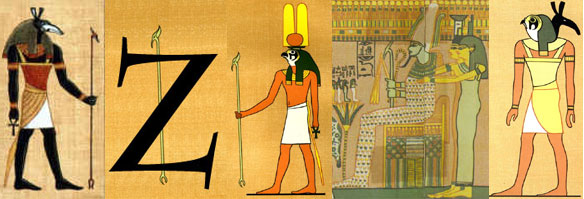
According to the foundation legend of Egypt, the evil god Set and a company of conspirators murdered Assur. They hacked his body into pieces and scattered his severed parts. Isis gathered together Assur's scattered parts and resurrected him from the dead. She then copulated with her resurrected king. The union of Assur and Isis produced their son, Heru. During Heru's growing-up years, Isis had to live on the run, hide in swamps, and resort to all manner of stratagems to protect her son from the fiends of Set who were out to kill him. When Heru reached maturity, he avenged the murder of his father in a horrible war against the forces of Set in which both parties suffered losses and injuries.
Despite all of this, Set and Heru often appear to be coequals in Egyptian art and symbolism. In some versions of the Judgment Scene, Assur is pictured holding only his crook and flail. In other versions he is seen holding the Set scepter along with his crook and flail. That suggests that Assur is an ancestor of Set and not his "brother" as some genealogies have it. In some cases, Set appears to be a brother of Heru. In other cases he seems to be the "dark side" of Heru. Many Egyptian gods are depicted holding a Set scepter in their hands. Possibly the Set scepters held in the hands of gods represent their power over evil forces within themselves or in the outer world. All in all, Set seems to have had a checkered career in Egyptian religion.
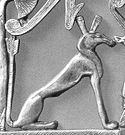
 Set, the unnamable animal with his forked tail, his scepter, and his reputation for evil is apparently the prototype for our conventional concept of Satan. According to the Biblical concept of the Devil, Satan was a "fallen angel." Set seems to have suffered the same fate in Egyptian religion. He began as one of the good gods and ended up as the devil. Before the dawn of dynastic Egypt, Set was a member of a venerated company of gods. By the end of the Twenty-sixth Dynasty, he was the personification of evil. Apparently Set lost his position in heaven through his involvement in the political power struggles of people on earth.
Set, the unnamable animal with his forked tail, his scepter, and his reputation for evil is apparently the prototype for our conventional concept of Satan. According to the Biblical concept of the Devil, Satan was a "fallen angel." Set seems to have suffered the same fate in Egyptian religion. He began as one of the good gods and ended up as the devil. Before the dawn of dynastic Egypt, Set was a member of a venerated company of gods. By the end of the Twenty-sixth Dynasty, he was the personification of evil. Apparently Set lost his position in heaven through his involvement in the political power struggles of people on earth.
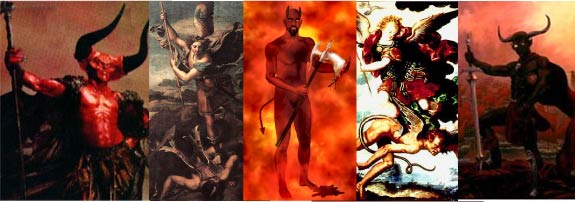
The minuscule letter z is a picture of a rattlesnake poised to strike.
"Their wine is the poison of dragons and the cruel venom of asps." Deut. 32:33.
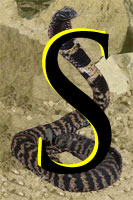
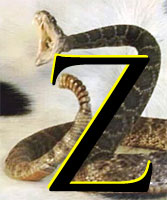 In the symbols that are letters of the alphabet, the minuscule letter s is a picture of a cobra poised to strike. The minuscule letter z is a picture of a rattlesnake poised to strike. Cobras are asps. In the Pagan religion, the Sacred Asp of Isis was a wisdom symbol. The serpent that spoke to Eve in the Garden of Eden was the Sacred Asp of Isis. God said "ye shall not eat of it [the forbidden fruit] lest ye die." The serpent said "your eyes shall be opened, and ye shall be as gods." The venom of asps is a psychoactive drug that they imbibed to make themselves wise.
In the symbols that are letters of the alphabet, the minuscule letter s is a picture of a cobra poised to strike. The minuscule letter z is a picture of a rattlesnake poised to strike. Cobras are asps. In the Pagan religion, the Sacred Asp of Isis was a wisdom symbol. The serpent that spoke to Eve in the Garden of Eden was the Sacred Asp of Isis. God said "ye shall not eat of it [the forbidden fruit] lest ye die." The serpent said "your eyes shall be opened, and ye shall be as gods." The venom of asps is a psychoactive drug that they imbibed to make themselves wise.
The Egyptians could cure snakebite. They had an antidote for the venom of asps. They kept cobras as house pets for their venom. They could cure the bite of the asp, but they had no antidote for the venom of vipers. The bite of a rattlesnake was a death sentence. Death from a viper's bite was a horrible death writhing in fever and agony. The bite of a rattlesnake was hell. The sound of letter z is derived from the buzz of the rattlesnake's tail.
ADDENDUM #1
Someone could argue that the sound of letter z couldn't possibly be from the buzz of a rattlesnake's tail because there were no rattlesnakes in Egypt nor where there any rattlesnakes in the "known world" of the Egyptians. The idea that the "known world" of the Egyptians was limited to the Mediterranean region is European fiction from the Christian era. The Genesis of Isis went everywhere, including North and South America. (See Alphabet Page L on this website.)
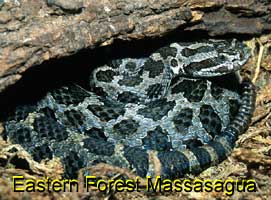
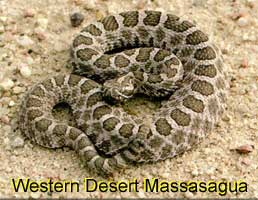 The Massasagua Rattlesnake is the most widespread species of rattlesnake in North America. It ranges from Ontario to Saskatchewan in the north, and from Florida to Arizona in the south. The Massasagua Rattlesnake's name is composed of M = Mother plus assas = Isis plus agua = water. The name Massasagua says Mother-Isis-Water.
The Massasagua Rattlesnake is the most widespread species of rattlesnake in North America. It ranges from Ontario to Saskatchewan in the north, and from Florida to Arizona in the south. The Massasagua Rattlesnake's name is composed of M = Mother plus assas = Isis plus agua = water. The name Massasagua says Mother-Isis-Water.
The Name Massasagua is an Algonquin Indian name. Apparently, the name Massasagua originally meant "Great-River-Mouth" in reference to its swampy habitat. However, Massasagua rattlesnakes also occupy desert habitats. The name of the Massasagua rattlesnake probably originated in the vicinity of the Mississagua River. The name Mississagua also says Mother-Isis-Water. The name of the Massapequa River in New York is another version of Mother-Isis-Water. The name of the Mississippi River is also a form of Mother-Isis-Water. Minions of Isis used the names of Pagan gods to give names to people and geographical features all over the world, including North America.
(See the Isis in North America page on this website.)
ADDENDUM #2

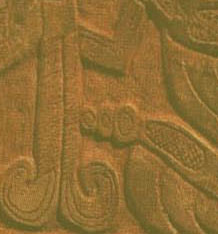 The genesis of Isis went everywhere. This carved wall panel from a Mayan temple in Central America is a Mayan version of the classical Egyptian Judgment Scene. In this Mayan Judgment Scene, a supplicant is making an offering to a bearded figure. Behind the bearded figure is another figure holding two winged serpents. Although the figure holding the serpents looks more like a man than a woman, the two winged serpents represent the double wisdom of twice-wise Isis, the serpent goddess. An examination of their tails reveals that the serpents in the Mayan Judgment Scene are definitely rattlesnakes.
The genesis of Isis went everywhere. This carved wall panel from a Mayan temple in Central America is a Mayan version of the classical Egyptian Judgment Scene. In this Mayan Judgment Scene, a supplicant is making an offering to a bearded figure. Behind the bearded figure is another figure holding two winged serpents. Although the figure holding the serpents looks more like a man than a woman, the two winged serpents represent the double wisdom of twice-wise Isis, the serpent goddess. An examination of their tails reveals that the serpents in the Mayan Judgment Scene are definitely rattlesnakes.
Egyptian missionaries carried knowledge of rattlesnakes back to Egypt from Central America. They may have taken live snakes or preserved specimens with them. Scribes of the Thoth school were well familiar with rattlesnakes when they created the alphabet.
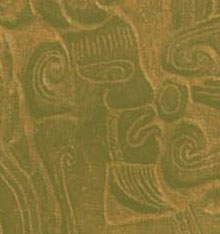 In Mayan, Aztec, and Inca art, the people are always depicted without beards. The judge in this Mayan Judgment Scene is a bearded god-man. According to Mayan legends, their "gods" left by sea going eastward and promised some day to return. When the bearded Spaniards arrived on their shores, the Mayans believed that their gods were returning. The beards of the Spaniards made it easy in the beginning for them to awe, deceive, and intimidate, a whole nation of native Americans with only a few soldiers.
In Mayan, Aztec, and Inca art, the people are always depicted without beards. The judge in this Mayan Judgment Scene is a bearded god-man. According to Mayan legends, their "gods" left by sea going eastward and promised some day to return. When the bearded Spaniards arrived on their shores, the Mayans believed that their gods were returning. The beards of the Spaniards made it easy in the beginning for them to awe, deceive, and intimidate, a whole nation of native Americans with only a few soldiers.
Some legends have it that the Indians of "New England" also believed that their gods were returning when Europeans arrived on their shores. The name Massachusetts begins with Mother-Isis. The native Americans were smooth skinned and beardless people of Asian origins. Nevertheless, stories and legends of bearded "gods" and hairy travelers from distant places are common throughout the Americas from Yukon to Yucatan.
(See the Isis in Central America page on this website.)
Resurrect Isis. We are all EarthMother's children, including the Eskimos of North America and the Indians of South America. Let us build a WorldCulture civilization of EarthMother's children that leaves out no part of humanity.
|
Reader responses are invited. |
Return to Home Page . . . Return to Table of Contents Hub
Links to alphabet pages:
Link to Alphabet Page X . . . Link to Alphabet Page Y
Links to related topic pages:
Isis in North America . . . Isis in Central America . . . Pagan Genesis . . . Visual Language . . . Alphabet Page L . . . Alphabet Page S